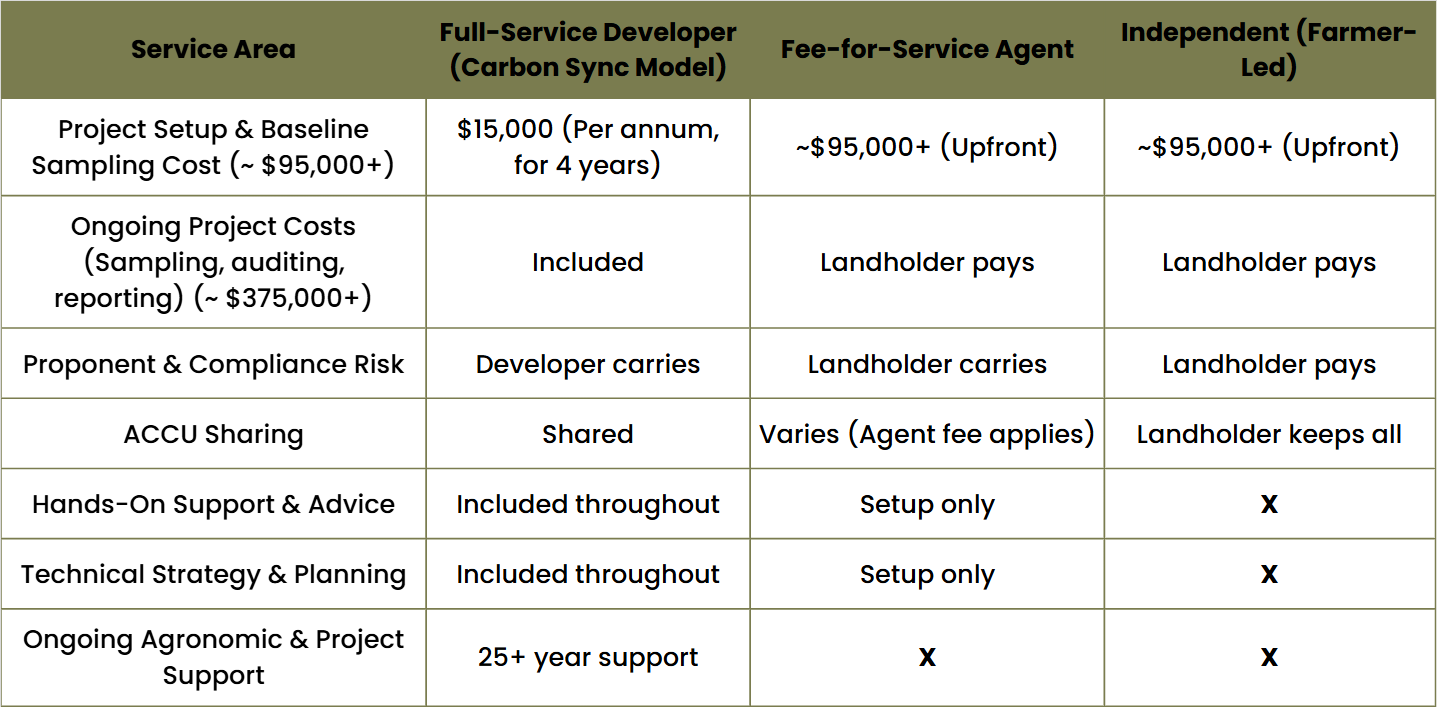
Let’s kick the tyres before we jump in.
Our projects are long-term, and so are the relationships behind them.
That’s why we start with a Cost-Benefit Report.
It’s a clear, honest look at whether carbon farming suits your land — and whether we’re the right team for the job. Part planning, part gut check, it helps you decide if the project has legs.
Even if you don’t go ahead, the report is yours to keep — a detailed, farm-specific blueprint of the opportunity.
Here’s what’s under the bonnet:
The Big Picture
A Clearer View, Built For You.
A sharp view of what’s possible on your land:
What value’s in reach — carbon, water cycling, biodiversity
Where the potential lies — and what your constraints are
How it fits your farm — not a template
It’s your farm. We just help you see its full worth.

Business Model Options
Every carbon project needs a solid structure — and a partner you trust. This section outlines your options, so you can choose what fits your farm, your schedule, and your appetite for risk.
We break down the numbers and realities of each option — going it alone, using a service provider, or partnering with us. You’ll see clearly who carries the risk, who does the work, and how returns are shared.
Our model is designed for dryland farming systems — with complexity, uncertainty, and time constraints in mind. That’s why we carry the lion’s share of the project costs, and all of the risk and compliance load, while you retain complete control over how you manage your land.
Because if this is going to work, it has to work for both of us — in practice, and on paper.
Calculations based on 1,000 ha example farm
Understanding Your Landscape
Before exploring what’s possible, we get clear on what’s there. This section maps your farm’s physical makeup — land shape, water flow, soils, and past use.
Using remote sensing, ground-truthing, and your insights, we define the Carbon Estimation Areas (CEAs) — the zones where change is measured and credits are earned.
This is how we lay the groundwork — literally — for a project that’s tailored to your farm’s shape, soils, and story.
-
Past and projected.
-
Ridges, valleys, elevations, and how they move water.
-
What’s flowing, what’s pooling.
-
What’s working for you, what isn’t, and how carbon storage can be optimised by looking deeply at your soils
-
What can be included in CEA’s and what can’t be
What Could Be Done Differently?
We Start Where It Matters The Most.
We don’t arrive with a prescription — because there’s no one-size-fits-all. And no silver bullet.
We start by finding the biggest constraint holding your system back — and fix that first. Then we scaffold around it.
This isn’t just about carbon. It’s about helping your farm function better, for longer.
We bring a practical toolbox — things like adaptive grazing with virtual fencing, stubble retention, or contouring for water capture — and explore what makes sense for your land.
Every choice is designed to stack value:
Carbon. Water Retention. Soil Health. Resilience.
Because this isn’t just practice change.
It’s system design that holds.
We Read the Land to See What’s Possible
Before we design anything, we read the land. Where it’s been. Where it’s heading.
We pull together your current practices — grazing, stubble management, rotations — and assess how small shifts could build more carbon and resilience. Then we layer in the deeper context: soil types, rainfall, erosion risks, and how the land holds water.
But we’re not just chasing carbon. We’re looking for function — the levers that lift productivity and restore life. That includes water retention, groundcover recovery, and rebuilding the small water cycle.
We also scan for climate risks and the opportunities they open — like swales, shelterbelts, or better grazing design.
It’s a map of what your farm already holds — and where the big changes could start.

What Could Get in the Way
We don’t pretend there’s no risk. We name it — and share it.
Farming’s always had its unknowns — droughts, market swings, shifting rules.
We don’t gloss over risks. We work through them — eyes open, feet grounded.
In every Carbon Sync project, we lay out the full stretch:
What we carry — like compliance, audits, and upfront system costs
What you carry — seasonal decisions, on-farm management
What no one can control — but we can plan for, together
We’ve built our model to make the risk load fair — especially for dryland farms
where resilience can’t be an afterthought.
What Could It Be Worth?
Scenarios, returns, and how the numbers stack up.
This section models your farm’s carbon sequestration potential — and what it could mean financially.
We explore different land response scenarios, estimate carbon credit volumes, and forecast returns over 25 years.
You’ll see how outcomes vary by business model: partnering with Carbon Sync, using a third party, or going solo — including income, developer share, and IRR.
These are conservative, evidence-based projections to help you decide if a project is viable and which model suits you best.
The Road Ahead
By this point, you’ll have a detailed, grounded view of what a functional farming project could look like on your farm.
The shape of the land, the system it’s holding, and what might be possible if we scaffold around the constraints.
Whether you decide to move forward or not, the report is yours.
It’s a map of your farm’s potential — built from real data, designed to help you make the call, and rooted in the idea that function comes first, carbon follows.
We’re here if you’re ready.
And if not — we hope this gave you a clear, honest picture of what’s possible.
Ready to Grow?
Yes! I’m ready to tell you about my farm
Not ready yet. I’ll just have a cuppa with Carl








